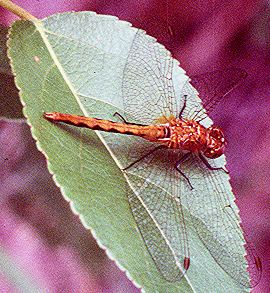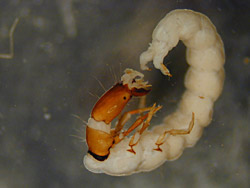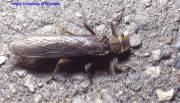 Aquatic Insects of Michigan
Aquatic Insects of Michigan
by Ethan Bright, Museum of Zoology Insect Division and School of Natural Resources and Environment
University of Michigan
- Home
- Species Lists
- Coleoptera
- Diptera
- Ephemeroptera
- Acanthametropodidae
- Ameletidae
- Ametropodidae
- Arthropleidae
- Baetidae
- Baetiscidae
- Behningiidae
- Caenidae
- Ephemerellidae
- Ephemeridae
- Heptageniidae
- Isonychiidae
- Leptohyphidae
- Leptophlebiidae
- Metretopodidae
- Neoephemeridae
- Oligoneuriidae
- Palingeniidae
- Polymitarcyidae
- Potamanthidae
- Pseudironidae
- Siphlonuridae
- Heteroptera
- Hymenoptera
- Lepidoptera
- Megaloptera
- Neuroptera (Sisyridae)
- Odonata
- Orthoptera
- Plecoptera
- Trichoptera
- Other Orders
- Keys/Identification
- Aquatic Insects of Michigan
Introduction

Environmental managers, researchers and students now have a comprehensive and authoritative resource for learning about Michigan's aquatic insect fauna. Beginning with the resources and information here at the University of Michigan, this project will expand to include information from other research collections and institutions as well as investigators/collectors. The author would greatly appreciate information, collaboration or assistance as well as comments people would like to give regarding changes and additions to the information contained herein by emailing the author. I hope this project and web site is useful and enjoyable.
Project Scope
Pages contained in this project are accessed with the heirarchical menu to the left. The first item in the menu contains administrative project information, e.g., home page access, project/page updates, etc. Information about aquatic insects per se are in three sections:
 1) Species Lists. Species-lists and site locality information are displayed. Previous species-lists that were available on the WWW have been redesigned and incorporated into this larger project to document the distribution of freshwater insects in the state of Michigan. Currently, species-lists exist for most groups. Users will be able to determine what species have been recorded - or are likely to be recorded - from Michigan. In the future, as information becomes available and specimens processed, Michigan record localities will also be site-indicated using GIS-generated maps for each respective species with known latitude-longitude or TRS location. For now, species with verified Michigan localities are shown with bold lettering; species known from nearby locations and are likely to be found in Michigan are shown in regular lettering. Currently this part of the project is in its most advanced stage.
1) Species Lists. Species-lists and site locality information are displayed. Previous species-lists that were available on the WWW have been redesigned and incorporated into this larger project to document the distribution of freshwater insects in the state of Michigan. Currently, species-lists exist for most groups. Users will be able to determine what species have been recorded - or are likely to be recorded - from Michigan. In the future, as information becomes available and specimens processed, Michigan record localities will also be site-indicated using GIS-generated maps for each respective species with known latitude-longitude or TRS location. For now, species with verified Michigan localities are shown with bold lettering; species known from nearby locations and are likely to be found in Michigan are shown in regular lettering. Currently this part of the project is in its most advanced stage.
2) Identification Resources and Keys. Taxonomic and other identification resources provide users with information necessary to identify aquatic insects from our region. At first borrowing heavily from published literature, this section hopefully will be improved through the contributions of active researchers and taxonomic/systematic experts. Keys and other diagnostic resources are being developed for most groups, although this is not currently possible for some of the larval and pupal holometabolous groups, especially family- and genus-level keys. Species-level keys may also appear if other people can lend their help with this project.
Since the inception of this page over 10 years ago, much effort has been made to thoroughly survey a number of insect orders in Michigan. Since the inception of the Michigan Odonata Society, and the numbers of members active in collecting, we have an excellent inventory of species that occur in the state. A number of surveys have been published for Plecoptera and Ephemeroptera that have greatly improved our knowledge. Megaloptera is also well surveyed, due to the few number of species that likely occur here. Also, new efforts have been made to update lists of Trichoptera, and it is expected that a fairly complete inventory will soon be published. Reasonably updated lists have been constructed for most other orders, but doubtless additional taxa will be added for the other homometabolous aquatic/semiaquatic orders with more thorough state-wide collecting efforts.
What's New...
Changes to pages in the website:
- March 30, 2024 - Zavrelia parapentatoma and Parachaetocladius lenferringtoni (Diptera: Chironomidae, Chironominae and Orthocladiinae) added to the state list
March 09, 2024 - Somatochlora ensigera and Argia translata (Odonata) added to the state list - February 24, 2024 - Website is now assigned with a SSL (secure sockets layer) certificate, a digital authentication of the website's identity and enabling an encrypted connection. Some browsers and institutions require this in order for the website to be displayed. If you are still finding difficulty in connecting from certain sites, please notify the webmaster.
- February 16, 2024 - Wesolek and Bright (publ. in prep) report Fletcherimyia fletcheri (Sarcophagidae: Diptera) from Brimley, MI
- November 05, 2023 - Gerald Shepard reports Maccaffertium mexicanum integrum being found in Manistique, MI
- June 7, 2020 - Updated species lists to Hydrophilidae and Helophoridae (added H. smetanai Hilsenhoff and removed H. artus Smetana from list, not likely to occur in M, moved H. tumidus LeConte to Limnohydrobius); added keys to Helophoridae (Helophorus) and Hydrophilidae
May 31, 2020 - Updated family-level key to Coleoptera - May 22, 2020 - Added key to Enallagma (Odonata: Coenagrionidae)
- May 19, 2020 - Added keys to Argia and Nehalennia (Odonata: Coenagrionidae)
- May 12, 2020 - Updated keys to Philopotamidae (Trichoptera)
- May 7, 2020 - Updated species list for Amphipoda
- April 19-23, 2020 - Species list for Odonata updated; added or updated keys for Aeshna, Arigomphus, Boyeria, Cordulegastridae, Celithemis, Gomphaeschna, Libellula, Leucorrhinia, Macromiidae, Pantala, Phanogomphus, Rhionaeschna, Somatochlora, Tramea (Odonata)
- April 10, 2020 - Updated species lists for Sciomyzidae and Syrphidae (Diptera)
- January 20, 2018 - Trichoptera species list to reflect publication of Houghton et al. 2018
- January 23, 2015 - Key to the Coleoptera has been added
- June 24, 2014 - A recent paper (Jacobus & Wiersema 2014) evidences that the baetid genus Centroptilum (Ephemeroptera) does not occur in North America, and our species formerly included in that genus belong to Neocloeon (alamance and triangulifer) and Anafroptilum (album and victoriae).
- December 04, 2013 - Key to the Dixidae (meniscus flies), Ptychopteridae (phantom crane flies), and Simuliidae (black flies) of Michigan is now available
- November 23, 2013 - Key to the Culicidae (mosquitoes) of Michigan is now available
- November 17, 2013 - Bruce McCulloch records Rhyacophila lobifera from the Rouge River watershed in southeastern Michigan
Last updated: April 07, 2024 (EB)